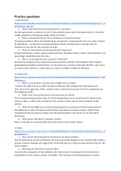Resume
Summary AQA A-Level 2L: Fascist society, 1926–1940 (A* achieved)
- Cours
- Établissement
A comprehensive set of notes for the AQA A-Level 2L Italy and Fascism, c1900–1945 course. Covers Fascist society, 1926–1940. Includes: propaganda, education, economic policies and fascist society.
[Montrer plus]












